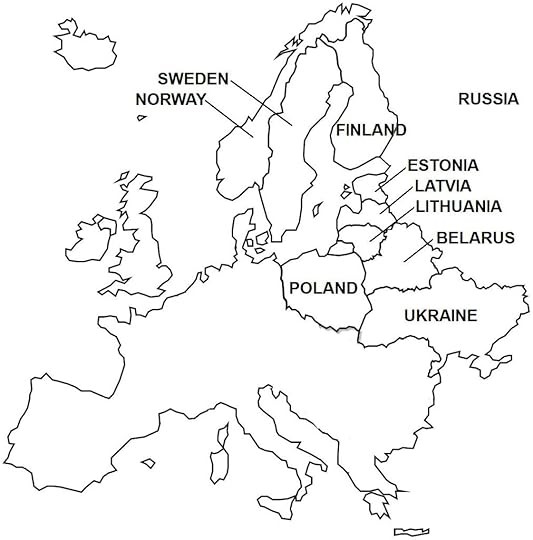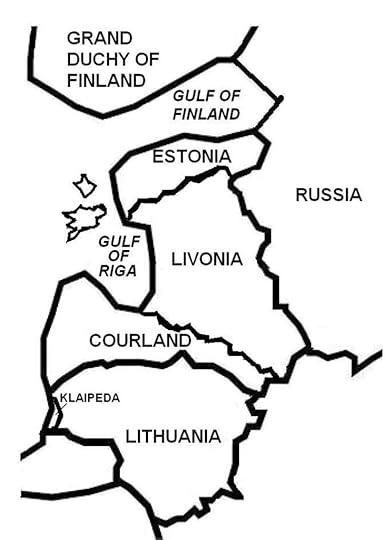January 13, 1920 – Latvian War of Independence: Soviet Russia ceases its support for the Latvian Soviet Socialist Republic
The final combat phase ofLatvia’sindependence war occurred on January 3, 1920 when the combined Latvian andPolish Armies attacked and captured Latgale, freeing the last Latvian territorystill held by the Red Army. Then afterachieving another decisive victory at the Battle of Daugavpils (fought under harsh, sub-zerowinter conditions), the Latvian-Polish forces pushed the Red Army into Russianterritory. Polish forces then withdrewfrom Latgale after turning over the territory to the Latvians. The Russian government ceased its support forthe Latvian Soviet Socialist Republic, whichdisbanded on January 13, 1920.

(Taken from Latvian War of Independence – Wars of the 20th Century –Vol. 4)
Background As aresult of the Northern Crusades in the 13th century, the variousindigenous peoples inhabiting the eastern Baltic region (which includes thelands that comprise present-day Latvia)were converted to Christianity. Germancrusader-knights of the Teutonic Order founded Riga(the present-day capital of Latvia)from where they conquered the adjacent regions, including the territory to thenorth that now constitutes modern-day Estonia. German settlers then arrived and settled inthe regions, and Riga was transformed during themedieval period into a major center of the Hanseatic League, which was an economic and trade alliance of many major cities along thecoasts of the North and Baltic Seas. As a result of these invasions, the ethnicGerman conquerors gained political, economic, and social ascendancy in Latvia(which largely would persist for the next 700 years) by acquiring vast tractsof land that were converted to feudal agricultural manorial estates worked byethnic Latvians who were relegated to the status of peasant laborers.
In 1561, the Polish-Lithuanian Commonwealth, aconfederated empire of two sovereign states, gained control of large portionsof Latvian territory, which in turn, after the Polish-Swedish War ended in 1629, it ceded to theSwedish Empire. In 1721, the SwedishEmpire, following its defeat in the Northern Wars, yielded the territory to the victorious and emerging RussianEmpire. In the Polish-Lithuanian,Swedish, and Russian conquests, the local German authority in Latvia, now forming the “BalticGerman nobility”, was allowed to maintain local rule on behalf of the greatercolonial power. Latvia under Tsarist Russia was ruled under twojurisdictions: the Governorate (province) of Courlandon the west and Governorate of Livonia. The latter comprised the ethnic Estonian northern region and the ethnicLatvian southern region – upon the independence of Estonia and Latvia, theGovernorate of Livonia’s Estonian north became part of Estonia while theLatvian south merged with the Governorate of Courland to form the Latvian state(Figure 20).
By the mid-19thcentury, as a result of the French Revolution (1789-1799), a wave ofnationalism swept across Europe, a phenomenon that touched into Latvia aswell. The Latvian nationalist movementwas led by the “Young Latvians”, a nationalist movement of the 1850s to 1880sthat promoted Latvian identity and consciousness (as opposed to the prevailingGermanic viewpoint that predominated society) expressed in Latvian art,culture, language, and writing. TheBaltic German nobility used its political and economic domination of society tosuppress this emerging Latvian nationalistic sentiment. The Russian government’s attempt at“Russification”(cultural and linguistic assimilation into the Russian state) was rejected byLatvians. The Latvian national identityalso was accelerated by other factors: the abolition of serfdom in Courland in1817 and Livoniain 1819, the growth of industrialization and workers’ organizations, increasingprosperity among Latvians who had acquired lands, and the formation of Latvianpolitical movements.
The Russian Empireopposed these nationalist sentiments and enforced measures to suppressthem. Then in January 1905, the socialand political unrest that gripped Russia(the Russian Revolution of 1905) produced major reverberations in Latvia, starting in January 1905, when massprotests in Rigawere met with Russian soldiers opening fire on the demonstrators, killing andwounding scores of people. Localsubversive elements took advantage of the revolutionary atmosphere to carry outa reign of terror in the countryside, particularly targeting the Baltic Germannobility, torching houses and looting properties, and inciting peasants to riseup against the ethnic German landowners. In November 1905, Russian authorities declared martial law and broughtin security forces that violently quelled the uprising, executing over 1,000dissidents and sending thousands of others into exile in Siberia.
Then in July 1914, WorldWar I broke out in Europe, with Russiaallied with other major powers Britainand France as the TripleEntente, against Germany, Austria-Hungary, and the Ottoman Empire that comprised the major Central Powers. In 1915, the armies of Germany and Austria-Hungary made military gainsin the northern sector of the Eastern Front; by May of that year, German unitshad seized sections of Latvian Courland and Livonian Governorates. A tenacious defense put up by the newlyformed Latvian Riflemen of the Imperial Russian Army held off the Germanadvance into Rigafor two years, but the capital finally fell in September 1917.
Meanwhile, by 1917, theRussian Empire was verging on a major political collapse at home afterexperiencing a number of devastating military defeats in the Eastern Front ofthe war,. Two revolutions broke out thatyear. The first, on March 8 (this daybeing February 23 in the Julian calendar that was used in Russia at that time,hence the historical name, “February Revolution” denoting the event; in January1918, Russia, by now ruled by the Bolsheviks, adopted the Gregorian calendarthat was already in use in Western Europe), led to the end of three centuriesof Romanov dynastic rule in Russia with the abdication of Tsar NicholasII. A Russian Provisional Government wasinstalled to administer the country which it declared as the “Russian Republic”.
The second revolution of1917 occurred on November 7 (October 25 in the Julian calendar, thus thepopular name “October Revolution” denoting this event), where the communistBolshevik Party came to power by overthrowing the Russian ProvisionalGovernment in Petrograd, Russia’s capital. The two 1917 revolutions, as well as ongoing events in World War I,catalyzed ethnic minorities across the Russia Empire, resulting in the variousregional nationalist movements pushing forward their political objectives ofseceding from Russiaand forming new nation-states. In thewestern and northern regions of the empire, the subject territories of Poland, Belarus,Ukraine, Lithuania, Latvia,Estonia, and Finland moved toward secession from Russia.
 Imperial Russian governorates of Estonia, Livonia, and Courland
Imperial Russian governorates of Estonia, Livonia, and CourlandThe Bolsheviks, on comingto power in the October Revolution, issued the “Declarationof the Rights of the Peoples of Russia” (on November 15, 1917), which grantedall non-Russian peoples of the former Russian Empire the right to secede fromRussia and establish their own separate states.Eventually, the Bolsheviks would renege on this edict and suppress secessionfrom the Russian state (now known as Russian Soviet Federative Socialist Republic,or RSFSR). The Bolshevik revolution alsohad succeeded partly on the communists promising a war-weary citizenry that Russiawould withdraw from World War I; thereafter, the Russian government declaredits pacifist intentions to the Central Powers. A ceasefire agreement was signed on December 15, 1917 and peace talksbegan a few days later in Brest-Litovsk (present-day Brest,in Belarus).
However, the CentralPowers imposed territorial demands that the Russian government deemedexcessive. On February 17, 1918, theCentral Powers repudiated the ceasefire agreement, and the following day, Germany and Austria-Hungaryrestarted hostilities, launching a massive offensive with one million troops in53 divisions along three fronts that swept through western Russia and captured Ukraine Belarus, Lithuania, Latvia,and Estonia. German forces also entered Finland, assisting thenon-socialist paramilitary group known as the “White Guards” in defeating thesocialist militia known as “Red Guards” in the Finnish Civil War. Eleven days into the offensive, the northernfront of the German advance was some 85 miles from the Russian capital of Petrograd.
On February 23, 1918, orfive days into the offensive, peace talks were restarted at Brest-Litovsk, withthe Central Powers demanding even greater territorial and military concessionson Russia than in the December 1917 negotiations. After heated debates among members of theCouncil of People’s Commissars (the highest Russian governmental body) who wereundecided whether to continue or end the war, at the urging of its Chairman,Vladimir Lenin, the Russian government acquiesced to the Treaty ofBrest-Litovsk. On March 3, 1918, Russianand Central Powers representatives signed the treaty, whose major stipulationsincluded the following: peace was restored between Russia and the CentralPowers; Russia relinquished possession of Finland (which was engaged in a civilwar), Belarus, Ukraine, and the Baltic territories of Estonia, Latvia, andLithuania – Germany and Austria-Hungary were to determine the future of theseterritories; and Russia also agreed on some territorial concessions to theOttoman Empire.
German forces occupied Estonia, Latvia,Lithuania, Belarus, Ukraine,and Poland,establishing semi-autonomous governments in these territories that weresubordinate to the authority of the German monarch, Kaiser Wilhelm II. The German occupation of the region allowedthe realization of the Germanic vision of “Mitteleuropa”, an expansionist ambition aimed at unifying all Germanic andnon-Germanic peoples of Central Europe into agreatly enlarged and powerful German Empire. In support of Mitteleuropa, in the Baltic region, the Baltic Germannobility proposed to set up the United Baltic Duchy, a semi-autonomouspolitical entity consisting of present-day Latviaand Estoniathat would be voluntarily integrated into the German Empire. The proposal was not implemented, but Germanmilitary authorities set up local civil governments under the authority of theBaltic German nobility or ethnic Germans.



